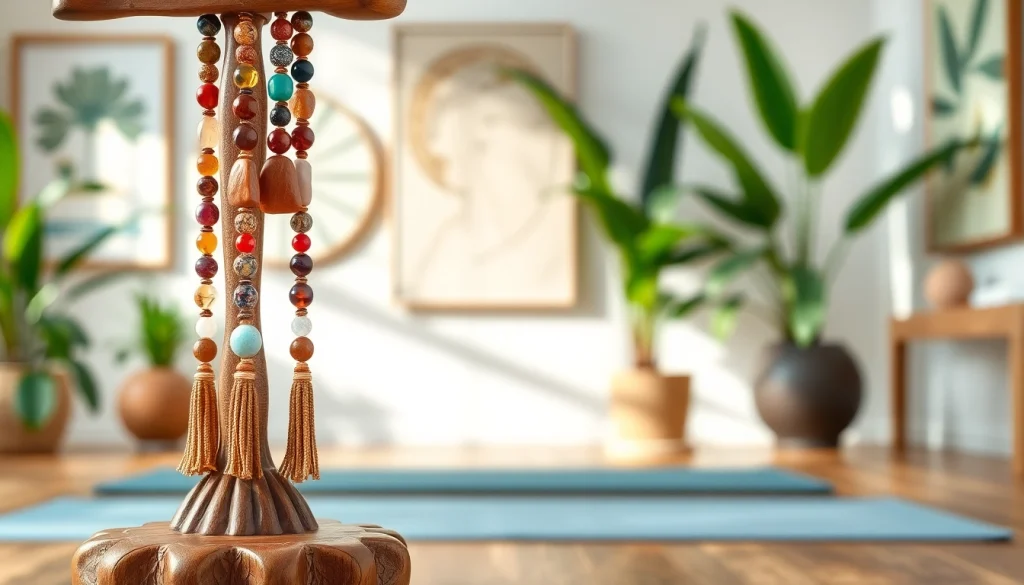Understanding Malas: Origins and Significance
Malas are more than just beautiful accessories; they are powerful tools used in meditation and spiritual practices across various cultures. Originating from ancient traditions, malas have become an essential part of mindfulness and meditation practices, allowing individuals to keep track of their mantras and enhance their focus. For anyone intrigued by these sacred beads, malas offer a gateway to deeper self-awareness and connection.
The History of Malas
The use of malas can be traced back thousands of years to ancient India, where they were first created to aid in meditation. The word “mala” itself comes from Sanskrit, meaning “garland.” Traditionally, malas consist of 108 beads, which is considered a sacred number in many spiritual traditions. Various cultures and religions – including Buddhism, Hinduism, and Jainism – have adopted the use of malas in their practices, counting mantras and prayers. They were initially made from natural materials like seeds, wooden beads, or gemstones, all selected for their unique properties and significance.
Cultural and Spiritual Importance
Malas hold immense cultural and spiritual significance, particularly in eastern traditions. In Buddhism, they are used for counting the recitations of mantras and maintaining focus during meditation. Each bead represents a single recitation, and the practice helps practitioners become more centered and tranquil. Similarly, in Hinduism, malas are integral to spiritual rituals and are often associated with specific deities or spiritual teachings.
In contemporary settings, many people use malas for personal growth, emotional healing, and daily mindfulness practices. The growing interest in yoga and meditation across the globe has allowed malas to bridge cultures and connect individuals with their inner selves.
Modern Uses of Malas
Today, mala beads have transcended actual religious practices and are embraced widely for their aesthetic appeal and meditative utility. Many individuals incorporate them into their daily routines for gratitude, intention-setting, or simply to cultivate mindfulness during busy moments. Some contemporary designs include wrist malas or layered necklaces, allowing for versatility in how they can be worn or used.
Types of Malas: Exploring Varieties and Materials
Natural vs. Synthetic Beads
When exploring malas, you’ll find them made from various materials ranging from natural to synthetic options. Natural beads typically include materials such as seeds, gemstones, wood, and bones, each offering unique qualities, textures, and energies. For instance, rosewood malas are often chosen for their calming properties, while gemstone malas, using stones like amethyst or lapis lazuli, might be favored for their healing attributes.
On the other hand, synthetic beads provide a more cost-effective option and come in myriad colors and designs, appealing to those who value aesthetics over tradition. However, for those seeking authenticity and spiritual benefits, opting for natural materials is still encouraged.
Choosing the Right Length and Style
The standard mala traditionally consists of 108 beads, plus one guru bead, which serves as a stop point in counting. However, variations exist, including shorter strands of 54 beads or even 27, depending on personal preference and usage. When choosing a length, it’s essential to consider how you wish to use your mala, such as whether you will be wearing it as jewelry or using it primarily for meditation.
Style is also an important consideration. From classic rustic designs to sleek modern aesthetics, the style of your mala should resonate with your personal taste and the intention you set for your practice.
Traditional vs. Contemporary Designs
Traditional malas uphold the ancient practices and meanings associated with their materials and symbolism, often showcasing intricate craftsmanship passed down through generations. Contemporary designs, however, can offer a fresh take on these sacred creations, incorporating modern materials, colors, and usage patterns while still enhancing mindfulness.
Ultimately, whether a mala embodies traditional or modern elements, the most important aspect is its ability to enhance your practice and ritual. Choose a design that resonates with you and aligns with your intentions.
How to Use Malas in Meditation and Mindfulness
Counting Mantras with Malas
The primary function of malas is to help practitioners count their mantras during meditation. The repetition of mantras creates a rhythm that can help ground the practitioner, allowing them to enter a deeper state of focus. To use malas effectively, hold the guru bead with your thumb and middle finger, setting your intention as you begin. Then, move to the next bead while chanting your mantra, repeating this process until you complete your cycle.
It’s vital to approach the practice with mindfulness, as the act of counting becomes a meditation in itself, centering your mind on the mantra and the experience. You can incorporate pauses to reflect on your intention, enhancing the experience further.
Creating Personal Rituals
Malas can serve as a central element in your personal rituals. Whether connecting with nature, practicing gratitude, or setting affirmations, weaving your mala practice into daily rituals uplifts its significance. Consider creating a dedicated space in your home for these practices, where you can enter a safe zone for mindfulness and intention-setting.
For instance, reserve time each morning or evening to sit with your mala, counting beads while reflecting on your goals or expressing gratitude. With consistent practice, you may find that the mala holds deeper meaning over time, transforming it into a cherished part of your spiritual journey.
Enhancing Your Meditation Practice
Integrating malas into your meditation routines can enhance your experience significantly. Beyond simply counting mantras, you can also explore the energetic qualities of different beads with each practice. For example, utilizing amethyst during meditations focused on healing can amplify your intention.
Each meditation can vary in approach based on the mala chosen. You might focus on breath awareness while using your mala or utilize it during visualization exercises, counting each bead as you visualize your intentions manifesting in your life. The key is to remain open to how the mala engages your practice and what insights emerge as you meditate.
Caring for Your Malas: Maintenance Tips
Cleaning and Storing Malas
Maintaining the quality and energy of your malas is crucial for longevity and efficacy in your practices. Regularly cleaning your mala can help keep it energized and free from negative energies. You can gently wipe the beads with a soft, dry cloth to remove dust and grime. For more thorough cleaning, soak the mala in warm, soapy water (if compatible with the materials), rinse, and let it dry completely before storage.
When storing your mala, avoid direct sunlight or exposure to moisture to prevent damage to the materials. Place them in a dedicated pouch or box, ideally lined with a soft fabric, to protect them from scratches and environmental factors.
Repairing Damaged Malas
As with any cherished item, your mala may experience wear and tear over time. If a bead becomes loose or the string frays, it’s important to repair your mala to maintain its symbolism and functionality. Many people opt for professional repair services specializing in malas; however, if you’re confident in your crafting skills, you can also learn to restring them. Make sure to use quality materials and take care to maintain the structure and energy of your mala during the process.
How to Recharge Your Malas’ Energy
The belief in the energetic properties of beads also extends to the idea that malas should be regularly “recharged.” Various practices exist for this purpose, including leaving your mala in the moonlight overnight or burying them in salt for a few hours. For more personalized energy-boosting techniques, you might also consider incorporating practices like placing your mala on a crystal or using it during specific rituals or ceremonies.
Shopping for High-Quality Malas: What to Look For
Identifying Genuine Materials
When shopping for malas, quality is key. To ensure you’re investing in a genuine mala, familiarize yourself with the materials commonly used. Natural resources, like sandalwood, rosewood, and certain gemstones, often have unique textures, scents, or appearances indicative of their authenticity. Avoid synthetic replicas unless aesthetic appeal is your primary consideration.
Pay attention to the craftsmanship, knotting, and string quality. Well-crafted malas should exhibit securely tied loops between each bead, which helps maintain their integrity and preserves energy flow during use. If available, inquire about the sourcing of materials to ensure they are ethically and sustainably obtained.
Ethical Sourcing and Craftsmanship
As with any handmade item, understanding where and how your mala is made is essential. Support artisans and suppliers who prioritize ethical sourcing and sustainable practices. Not only do these factors contribute to the overall quality of your mala, but they also add to its significance. Seek out brands or artisans who are transparent about their processes and who honor traditional techniques and materials.
Where to Buy Authentic Malas
For those seeking authentic malas, the best places often include specialized shops focusing on spiritual or meditation-related products. Many dedicated online retailers offer a curated selection of malas, ensuring quality and authenticity in their collections. Local yoga studios or meditation centers can also be excellent resources for authentic malas, as they frequently sell items aligned with their mindful practices. Always take time to explore and ask questions about the malas you’re considering to find one that resonates fully with your practice.


